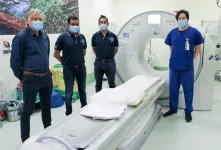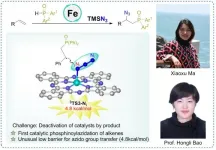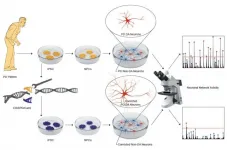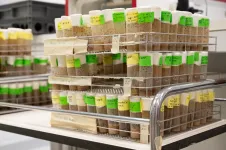(Press-News.org) Prostate cancer is the most diagnosed cancer and a leading cause of death by cancer in Australian men.
Early detection is key to successful treatment but men often dodge the doctor, avoiding diagnosis tests until it's too late.
Now an artificial intelligence (AI) program developed at RMIT University could catch the disease earlier, allowing for incidental detection through routine computed tomography (CT) scans.
The tech, developed in collaboration with clinicians at St Vincent's Hospital Melbourne, works by analysing CT scans for tell-tale signs of prostate cancer, something even a well-trained human eye struggles to do.
CT imaging is not suitable for regular cancer screening because of the high radiation doses involved, but the AI solution could be used to run a cancer check whenever men have their abdomen or pelvis scanned for other issues.
RMIT's Dr Ruwan Tennakoon said CT scans were great for detecting bone and joint problems but even radiologists struggled to spot prostate cancers on the images.
"We've trained our software to see what the human eye can't, with the aim of spotting prostate cancer through incidental detection," he said.
"It's like training a sniffer dog - we can teach the AI to see things that we can't with our own eyes, in the same way a dog can smell things human noses can't."
Prostate cancer is slow growing and is usually detected incidentally, so can go undiagnosed for years. In 2020, it was responsible for an estimated 12% of male cancer deaths in Australia.
*How it works*
For the study, published in Nature's Scientific Reports, researchers from RMIT and St Vincent's Hospital Melbourne studied CT scans of asymptomatic patients, with and without prostate cancer.
The team trained the AI software to look for features of disease in a variety of scans and where exactly to look for them, avoiding the need to manually crop the images.
The AI performed better than radiologists who viewed the same images, detecting cancerous growths in just seconds.
What's more, the AI improved with each scan, learning and adapting to read images from different machines to spot even the smallest irregularities.
RMIT's Head of Artificial Intelligence, Professor John Thangarajah, said the study demonstrated how AI can and should be used to create public good.
"Our health sector needs smarter solutions and AI can help, but we're only scratching the surface," he said.
"There's a lot of good that artificial intelligence can bring to the world, which is our focus at RMIT, and this study forms a big part of that."
Dr Mark Page, Head of CT in Diagnostic Imaging at St Vincent's Hospital Melbourne, said early intervention for prostate cancer was key to a better health outcome.
"Australia doesn't have a screening program for prostate cancer but armed with this technology, we hope to catch cases early in patients who are scanned for other reasons," he said.
"For example, emergency patients who have CT scans could be simultaneously screened for prostate cancer.
"If we can detect it earlier and refer them to specialist care faster, this could make a significant difference to their prognosis."
The technology can be applied at scale, potentially integrating with a variety of diagnostic imaging equipment like MRI and DEXA machines - pending further research.
"It was excellent to tap into the AI expertise at RMIT and we look forward to future possibilities for analysing more radiology scans," Page said.
The multi-disciplinary team, including researchers from RMIT's School of Engineering and School of Computing Technologies, is looking for interested commercial partners to develop software to further integrate the AI technology with hospital equipment for possible clinical trials.
INFORMATION:
'Incidental detection of prostate cancer with computed tomography scans', with Steven Korevaar, Ruwan Tennakoon, Mark Page, Peter Brotchie, John Thangarajah, Cosmin Florescu, Tom Sutherland, Ning Kam and Alireza Bab-Hadiashar, is published in Scientific Reports (DOI: 10.1038/s41598-021-86972-y).
Phosphinoylazidation of alkenes is a direct method to build nitrogen- and phosphorus-containing compounds from feedstock chemicals. Notwithstanding the advances in other phosphinyl radical related difunctionalization of alkenes, catalytic phosphinoylazidation of alkenes has not yet been reported. Thus, efficient access to organic nitrogen and phosphorus compounds, and making the azido group transfer more feasible to further render this step more competitive remain challenging.
Recently, a research team led by Prof. Hongli Bao from Fujian Institute of Research on the Structure of Matter, Chinese Academy of Sciences (CAS) reported the first iron-catalyzed phosphinoylazidation of alkenes under ...
The growing rate of ice melt in the Arctic due to rising global temperatures has opened up the Northwest Passage (NWP) to more ship traffic, increasing the potential risk of an oil spill and other environmental disasters. A new study published in the journal Risk Analysis suggests that an oil spill in the Canadian Arctic could be devastating--especially for vulnerable indigenous communities.
"Infrastructure along the NWP in Canada's Arctic is almost non-existent. This presents major challenges to any response efforts in the case of a natural disaster," says Mawuli Afenyo, lead author, University of Manitoba researcher, and expert on the risks of Arctic shipping.
Afenyo and his colleagues have developed a new ...
(Boston)--High-risk neuroblastoma is an aggressive childhood cancer with poor treatment outcomes. Despite intensive chemotherapy and radiotherapy, less than 50 percent of these children survive for five years. While the genetics of human neuroblastoma have been extensively studied, actionable therapeutics are limited.
Now researchers in the Feng lab at Boston University School of Medicine (BUSM), in collaboration with scientists in the Simon lab at the Perelman School of Medicine at the University of Pennsylvania (Penn), have not only discovered why this cancer is so aggressive but also reveal a promising therapeutic approach to treat these patients. These findings appear online in the journal Cancer Research, a journal ...
An international research team has found that despite being the world's leading cause of pain, disability and healthcare expenditure, the prevention and management of musculoskeletal health, including conditions such as low back pain, fractures, arthritis and osteoporosis, is globally under-prioritised and have devised an action plan to address this gap.
Project lead, Professor Andrew Briggs from Curtin University said more than 1.5 billion people lived with a musculoskeletal condition in 2019, which was 84 per cent more than in 1990, and despite many 'calls to action' and an ever-increasing ageing population, health systems continue to ...
Screens may be larger on smartphones now, but nearly every other component is designed to be thinner, flatter and tinier than ever before. The engineering requires a shift from shapely, and bulky lenses to the development of miniaturized, two-dimensional metalenses. They might look better, but do they work better?
A team of Japan-based researchers says yes, thanks to a solution they published on July 7th in Applied Physics Express, a journal of the Japan Society of Applied Physics.
The researchers previously developed a low-reflection metasurface -- an ultra-thin interface that can manipulate electromagnetic ...
Researchers from IDIBELL and the University of Barcelona (UB) have described that neurons derived from Parkinson's patients show impairments in their transmission before neurodegeneration.
For this study, it has been used dopaminergic neurons differentiated from patient stem cells as a model.
Parkinson's is a neurodegenerative disease characterized by the death of dopaminergic neurons. This neuronal death leads to a series of motor manifestations characteristic of the disease, such as tremors, rigidity, slowness of movement, or postural instability. In most cases, the cause of the disease is unknown, however, mutations in the LRRK2 gene are responsible for 5% of cases.
Current therapies against Parkinson's are focus on alleviating the symptoms but do not stop its progression. It ...
Scientists at the University of Southampton have discovered that changes in Earth's orbit may have allowed complex life to emerge and thrive during the most hostile climate episode the planet has ever experienced.
The researchers - working with colleagues in the Chinese Academy of Sciences, Curtin University, University of Hong Kong, and the University of Tübingen - studied a succession of rocks laid down when most of Earth's surface was covered in ice during a severe glaciation, dubbed 'Snowball Earth', that lasted over 50 million years. Their findings are published in the journal Nature Communications.
"One ...
By combining two distinct approaches into an integrated workflow, Singapore University of Technology and Design (SUTD) researchers have developed a novel automated process for designing and fabricating customised soft robots. Their method, published in Advanced Materials Technologies, can be applied to other kinds of soft robots--allowing their mechanical properties to be tailored in an accessible manner.
Though robots are often depicted as stiff, metallic structures, an emerging class of pliable machines known as soft robots is rapidly gaining traction. ...
Despite having been formalized as a species in 1936, Wolbachia pipientis remains an elusive microbe. The reason why relates to the relationship it establishes with its hosts. Wolbachia lives inside the cells of 40% of the arthropods, in their majority insects, intertwined in a symbiosis so complex that it can no longer survive on its own. "Guessing what it takes to grow and manipulate it outside the host might not be possible", says Luís Teixeira, IGC principal investigator. And, so far, despite countless attempts, no one has succeeded in culturing this bacterium or modifying its genetic sequence.
Before joining the team led by Luís Teixeira, Elves Duarte was interested in studying the symbiosis between ...
East Hanover, NJ. July 7, 2021. A team of researchers identified nine meaningful reasons that prevent people with disabilities from seeking employment. Their findings provide a much-needed understanding of this population's motives for remaining unemployed, which can inform programs and policies that promote labor force participation of people with disabilities. The article, "Understanding Persons with Disabilities' Reasons for Not Seeking Employment" (doi: 10.1177/00343552211006773) was published in Rehabilitation Counseling Bulletin on April 15, 2021.
The authors are Denise C. Fyffe, PhD, Anthony H. Lequerica, PhD, and John O'Neill, PhD, of Kessler Foundation; Courtney Ward-Sutton, PhD, and Natalie F. Williams, PhD, of Langston University; and Vidya Sundar, OT, PhD, ...






